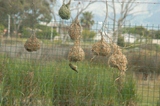Weaver news
| Farine DR, Downing CP, Downing PA. 2014. Mixed-species associations can arise without heterospecific attraction. Behavourial Ecology online. Abstract. Despite widespread research on the interaction rules that drive group-living behavior in animals, little is known about the spatial self-organization of individuals in heterospecific groups. This has led to significant challenges in teasing apart the various mechanisms thought to underpin multispecies groups. One potentially useful approach for gaining an understanding of this process is to identify the rules that best predict the observed distribution of individuals across these groups. In order to gain an insight into the decision-making process that might generate patterns of heterospecific associations, we collected data on the number and distribution of nests in breeding
This study was conducted on the Kisenyi plains, Queen Elizabeth National Park, Uganda, during July 2012. This coincided with the rainy season, during which weaver breeding was synchronized. The weavers studied were Black-headed (or Yellow-backed) Weaver, Village (or Black-headed) Weaver, and Lesser Masked Weaver. The authors counted a total of 2261 nests, of which 770 (34%) were of the Lesser Masked Weaver, 1063 (47%) of Village Weaver, and 428 (19%) of Black-headed Weaver. Literature as featured in Weaver Watch news items |











 colonies that contained 3 species of weaverbird. We found no evidence of segregation by species, either within or between colonies. Using agent-
based simulations of males applying different rules of attraction and repulsion to conspecifics or heterospecifics, we found that the best-fitting rule contained no heterospecific attraction. In this rule, individuals picked colonies based on an optimal distribution of conspecific nests. Given that nests are an important sexual signal in weavers, our findings suggest that this rule is biologically relevant: Males are seeking an optimal trade-off between attracting females via lekking and competing for mates if too many conspecific nests are present.
colonies that contained 3 species of weaverbird. We found no evidence of segregation by species, either within or between colonies. Using agent-
based simulations of males applying different rules of attraction and repulsion to conspecifics or heterospecifics, we found that the best-fitting rule contained no heterospecific attraction. In this rule, individuals picked colonies based on an optimal distribution of conspecific nests. Given that nests are an important sexual signal in weavers, our findings suggest that this rule is biologically relevant: Males are seeking an optimal trade-off between attracting females via lekking and competing for mates if too many conspecific nests are present.